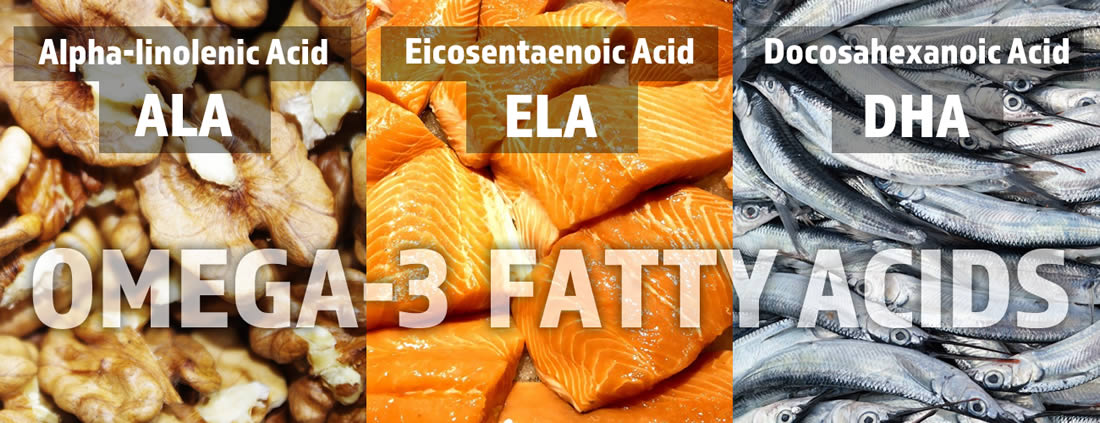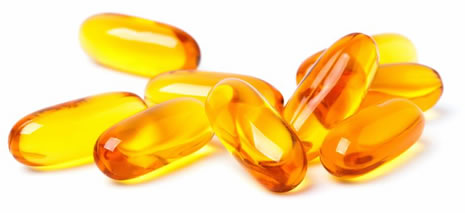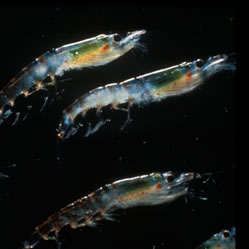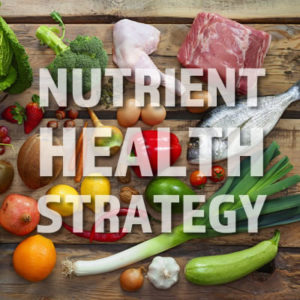Omega-3
The three types of omega−3 fatty acids important to the body are α-linolenic acid (ALA), found in plant oils, and eicosapentaenoic acid (EPA) and docosahexaenoic acid (DHA), both commonly found in marine oils. There are actually 11 different types. Just like the omega-6s, omega-3 fatty acids cannot be made by the body and we must get them from the diet.

- EPA and DHA are found in oily fish, seafood and quality fish oil supplements.
- ALA is found only in plants such as walnuts and flax seeds. Our bodies can poorly convert ALA to EPA and DHA. (estrogen levels improve conversion, so it's better in women).
Most Western diets are deficient in omega-3 fats. Omega-3's fats are anti-inflammatory, help regulate heartbeats, ensure healthy blood clotting and reduce the build up of fat in our arteries. Omega-3's lower the risks of having a heart attack or stroke. Not having enough omega-3 whilst having too many omega-6 fats can actually heighten the risk of heart disease, stroke and diabetes. Omega-6 fats primarily come from vegetable oils such as sunflower oil, corn oil and soy bean oil (and they are often GMO too.
Omega-6 is added to way too many processed foods like pastries & cakes, biscuits, crisps, snacks, take-away food, ready meals, breads, margarine and breakfast cereals.
The RDA for omega-3 is 250-500mg and the upper safe limit is 3000mg. 1000mg per day is a superb dosage. The main source of omega-3 is oily fish. The following are omega-3 content (mg) in a 100g portion:
- Wild sockeye salmon, 1800mg (this is listed top because it has less fat and more protein than farmed fish...... but the sockeye is super rich in the powerful anti-oxidant called astaxanthin and vitamin D. Farmed salmon is also a cruel industry and the fish are fed an unnatural diet that is high in toxins.
- Wild Atlantic Salmon 2,000mg. Farmed salmon should be avoided. Each pen is about 100 feet square and 100 feet deep. A single pen holds 50-90,000 fish. A large farm may have 3 million fish in pens. It is a very toxic farming method.
- Herring, 2,100mg (Herring is a small, wild-caught fish common in European cuisine - also super for vitamin D - also super when pickled).
- Anchovies, 2,100mg
- Sablefish/Black Cod 1,600mg
- Canned sockeye salmon (Native Alaska) 1,500mg
- Bluefin tuna, 1,400mg
- Halibut, 1,100mg
- Mackerel, 1,200mg
- Sardines, 900mg (sardines are super rich in vitamin B12 and selenium, plus many other micro-nutrients).
- Trout, 900mg
- Mussels, 700mg
Fish oil scams
You would probably struggle to find a person that isn't taking a fish oil capsule. But most people haven't a clue about the quality of the fish oil and the amount of EPA and DHA that they are consuming. Many decades ago, cod liver oil was given to children via a spoon. But a combination of the awful taste and the scarcity of cod made this practice unfavourable. But then the fish processors discovered that they could put fish oil into a gel cap and market it as a health supplement.

Gel caps are composed of gelatin manufactured from the collagen of animal skin or bone. Vegetable capsules are composed of hypromellose, a polymer made from cellulose.
Fish oils, rich in omega-3, have become one of the most popular dietary supplements worldwide with millions of regular consumers. Sales in the USA alone exceed US$ 1 billion annually. But here lies the problem.....
- Not all fish oils are equal.
- Rancid oils from the unwanted innards of old fish can be heavily processed into "good" fish oil.
- Fish oil supplements contain oxidised oils and rancid oils.
- Poor quality fish can be used. For instance, Baltic fish that are banned in many countries as food, due to there contamination levels, are used in the fish oil supplements. Low quality contaminated fish are also used as fish food for the salmon farms.
- A gel cap contains about 1000mg of oil. But a much smaller proportion is actually DHA and EPA.
- Some of the biggest brands are low quality, just a marketing exercise.
- One of the main benefits of omega-3, touted by the supplement industry, is the reduction is heart disease risk. But this claim is based upon the incorrect theory that higher cholesterol caused heart attacks. A 2018 study found that taking fish oil supplements have almost no benefits in terms of heart health.
- A cheap supermarket fish oil brand is almost certainly garbage.
- Most fish oils are in the ethyl ester (EE) form. The triglyceride (TG) and free fatty acid forms absorbed slightly better. the EE for is much better absorbed with a fatty meal. The TG form is naturally found in fish, but it can’t be concentrated. To produce an concentrated pharmaceutical grade fish oil, it is necessary to convert the TG form into EE.
UNLESS YOU DO YOUR HOMEWORK AND GET A QUALITY FISH OIL, YOU MAY BE DOING MORE HARM THAN GOOD. IT IS FAR BETTER TO GET YOU OMEGA-3s FROM FOOD - PLUS YOU WILL BE GETTING LOTS OF OTHER MICRO- NUTRIENTS.
The market ranges from gel caps made from line-caught fish oils that are extracted from wild fish (high in omega-3), right right through to cheap industrialised bulk gel caps made from very poor quality farmed fish (with little or no omega-3).
Omega-3 oils are called n-3 PUFA's. They are very prone to oxidation and breakdown, making fish oils one of the most volatile supplements sold to the public. In a recent study of major brands, 50% exceeded limits for at least one measure of oxidation, and 40% exceeding the international safety recommendations for total oxidation (TOTOX) values. In the USA, nearly a third of products tested were found to have more than twice the recommended levels of lipid peroxides, but in other countries, more than 80% of supplements exceeded recommended levels. The rate of oxidation of fish oils are influenced by exposure to oxygen and light, temperature, antioxidant content and the presence of water and heavy metals. Oxidation of fish oils leads to increased levels of hydroperoxides, which decompose into a variety of radicals inside your body. These react with other PUFAs to form more hydroperoxides and secondary oxidation products such as volatile ketones and alcohols. These are strongly linked to the rancid smell.
Omega-3 intake strategy
- Fish oil is not just omega-3. You need maximum levels of DHA and EPA. Poor gel caps contain inflammatory vegetable oils and rancid/oxidised fish oils.
- If the DHA and EPA content is too small to read, it's probably done for a reason!
- You should go for a fish oil that has a combines DHA and EPA level of at least 500mg. but you have to look at the cost/benefit of taking supplements, it might be more economic to consume a few portions of some quality oily fish each week, not to mention the added micro-nutrients you will be getting. Restaurant salmon is most probably going to be farmed, so you won't know how much omega-3 you will be getting.
- Quality oils usually have a third-party laboratory certification. You must avoid toxins and have oils that have a low degree of oxidation.
- Most fish oils are in the ethyl ester form. We recommend buying fish oils in the triglyceride and free fatty acid forms because they are absorbed much better.
- Krill oil is the best source of omega-3 as a supplement.
- Line-caught cod liver oil is an excellent source of omega-3.
Adequate intake: 500mg per day.
Theraputic dose: 1000-2000mg
Upper tolerable limit: 3000mg.
Sources: ncbi.nlm.nih.gov,


